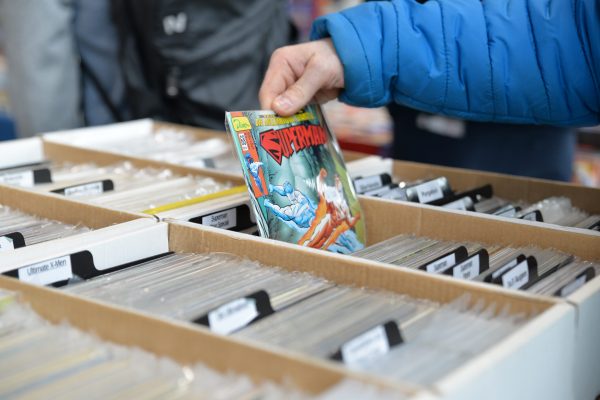Home>Storage & Organization>Closet & Wardrobe Organization>How To Organize Kids Books


Closet & Wardrobe Organization
How To Organize Kids Books
Published: March 2, 2024
Discover effective tips for closet and wardrobe organization to keep your kids' books tidy and easily accessible. Learn how to create a functional and visually appealing storage solution.
(Many of the links in this article redirect to a specific reviewed product. Your purchase of these products through affiliate links helps to generate commission for Storables.com, at no extra cost. Learn more)
Introduction
Are you tired of stepping on scattered kids books all over the house? Do you find it challenging to keep your children's reading materials organized and easily accessible? Worry no more! In this article, we will explore practical and creative ways to organize kids books in your home. From creating a sorting system to making reading spaces more inviting, we've got you covered with tips and tricks to streamline the chaos and promote a love for reading in your little ones. Let's dive in and transform the book clutter into an organized literary haven!
Key Takeaways:
- Transform book chaos into an organized literary haven by sorting books by age, genre, and size, utilizing bookshelves, incorporating labels, and regularly decluttering to maintain an enjoyable reading experience for kids.
- Get kids involved in organizing their book collection, creating cozy reading spaces, and making reading areas accessible to foster a lifelong love for books and reading.
Read more: How To Organize A Recipe Book
Create a Sorting System
-
Sort by Age Group: Begin by categorizing the books based on the age appropriateness for your kids. This will help in ensuring that the content is suitable for their reading level and interests.
-
Categorize by Genre or Theme: Consider sorting the books by genre or theme, such as adventure, fantasy, animals, or educational. This will make it easier for kids to find books that match their current interests.
-
Separate Fiction and Non-Fiction: Distinguish between fiction and non-fiction books. This will help in creating a clear distinction between imaginative stories and factual information, making it easier for kids to choose what they want to read.
-
Arrange by Size: If you have a wide range of book sizes, consider organizing them accordingly. You can allocate specific shelves or sections for larger picture books and smaller shelves for chapter books or magazines.
-
Color Code: For younger children, color-coding the books can be a fun and visually appealing way to organize. Assign a color to each category or genre and use colored stickers or labels to mark the books accordingly.
By implementing a sorting system, you can streamline the process of finding and selecting books, making reading time more enjoyable and accessible for your kids.
Utilize Bookshelves and Bookcases
When it comes to organizing kids' books, bookshelves and bookcases are essential furniture pieces that can make a significant difference. Here's how you can make the most of them:
-
Adjustable Shelves: Opt for bookshelves with adjustable shelves to accommodate books of various sizes. This flexibility allows you to customize the shelf heights based on the dimensions of the books, ensuring efficient use of space.
-
Display Forward-Facing: Consider using bookshelves that allow for forward-facing display of books. This not only makes it easier for kids to see the covers of the books but also adds a decorative element to the room.
-
Bookcase with Cubbies: Bookcases with cubbies or compartments are ideal for organizing smaller books, magazines, or even book-related accessories. These cubbies can be labeled or designated for specific categories, making it easier for kids to locate their preferred reading materials.
-
Floating Shelves: In addition to traditional bookcases, consider incorporating floating shelves in the reading area. These can be used to display favorite books, creating an inviting and accessible reading nook.
-
Bookends and Organizers: Utilize bookends and organizers to keep books upright and prevent them from toppling over. This not only maintains the neatness of the shelves but also makes it easier for kids to grab a book without causing a domino effect of falling books.
By maximizing the use of bookshelves and bookcases, you can create an organized and visually appealing display of kids' books while ensuring easy access for young readers.
Incorporate Labels and Categories
When it comes to organizing kids' books, incorporating labels and categories can significantly enhance the accessibility and visual appeal of the reading area. Here's how you can effectively utilize labels and categories:
-
Clear and Visible Labels: Use clear and legible labels to mark different sections or categories of books. Whether it's labeling shelves, bins, or individual books, visible labels make it easier for kids to identify where specific books belong and where to find them.
-
Alphabetical or Numerical Order: For older children, organizing books alphabetically by title or author's name can be a practical approach. Alternatively, assigning numerical codes to different categories can also streamline the organization process.
-
Themed Categories: Create themed categories such as "Adventure Stories," "Science and Nature," "Fairy Tales," or "Historical Fiction." This not only adds an element of fun but also helps kids explore various genres and themes easily.
-
Personalized Bookmarks: Encourage kids to create personalized bookmarks for their favorite categories or genres. These bookmarks can be used to mark specific sections or shelves, adding a personal touch to the organization while making it easier for kids to navigate through their preferred reading materials.
-
Color-Coded Labels: Implement a color-coded labeling system to visually distinguish between different genres or age groups. For example, use specific colors for fiction, non-fiction, and different genres, making it visually appealing and easy to identify categories at a glance.
By incorporating labels and categories, you can create a well-organized and visually engaging space for kids' books, making it easier for young readers to explore and enjoy their literary collection.
Consider organizing kids’ books by category, such as fiction, non-fiction, and picture books. You can also sort them by age group or author to make it easier for kids to find and choose their next read.
Regularly Declutter and Donate
Regular decluttering is essential to maintain an organized collection of kids' books. Over time, children outgrow certain books or develop new interests, making it necessary to periodically assess and declutter the book collection. Here's how you can effectively declutter and donate kids' books:
-
Set a Schedule: Establish a regular schedule for decluttering the book collection. This could be done seasonally or annually, depending on the size of the collection and the frequency of acquiring new books.
-
Involve the Kids: Encourage your children to participate in the decluttering process. This not only teaches them the importance of organization but also allows them to make decisions about which books they are ready to part with.
-
Inspect for Wear and Tear: Check each book for signs of wear and tear, such as torn pages, scribbles, or damaged covers. Books that are no longer in good condition can be recycled or repurposed.
-
Donate to Libraries or Schools: Consider donating gently used books to local libraries, schools, or charitable organizations. Many institutions welcome book donations to enrich their collections and provide reading materials to children in need.
-
Support Book Drives or Community Events: Keep an eye out for book drives or community events that accept book donations. This is a great way to contribute to literacy initiatives and ensure that preloved books find new homes where they can be enjoyed by other children.
By regularly decluttering and donating kids' books, you not only maintain an organized and manageable collection but also contribute to promoting literacy and a love for reading in the community.
Read more: How To Organize Books By Category
Make Reading Spaces Accessible
Creating accessible and inviting reading spaces is crucial in fostering a love for books and encouraging children to engage in reading. Here's how you can make reading spaces more accessible for kids:
-
Cozy Reading Nooks: Designate a cozy reading nook in a well-lit and comfortable area of the house. This can be a corner of the living room, a window seat, or a dedicated reading area in their bedroom. Ensure that the space is equipped with soft cushions, blankets, and a well-positioned reading light to create a cozy and inviting atmosphere.
-
Low-Level Book Displays: Incorporate low-level book displays within reach of young readers. This can include wall-mounted shelves, book bins, or floor-level bookcases that allow kids to browse and select books independently. By making books easily accessible, children are more likely to engage in spontaneous reading sessions.
-
Reading Corners in Multiple Rooms: Extend the accessibility of reading spaces by incorporating small reading corners in various rooms of the house. Having books available in different areas encourages reading as a part of daily activities and relaxation, rather than being confined to a specific room.
-
Comfortable Seating Options: Provide a variety of seating options such as bean bags, floor cushions, or child-sized chairs to accommodate different reading preferences. Comfortable seating encourages kids to spend more time immersed in books, making the reading experience enjoyable and relaxing.
-
Interactive and Engaging Decor: Enhance the accessibility of reading spaces by incorporating interactive and engaging decor. This can include educational posters, maps, or artwork related to favorite books or characters. Interactive elements can spark curiosity and create an immersive reading environment.
-
Rotation of Books: Regularly rotate and update the selection of books in the reading spaces. Introducing new books and swapping out existing ones keeps the reading spaces fresh and exciting, encouraging kids to explore different genres and authors.
By making reading spaces accessible and engaging, you can create an environment that promotes independent reading and cultivates a lifelong love for books in children.
Encourage Kids to Participate
Encouraging kids to actively participate in the organization and maintenance of their book collection can instill a sense of responsibility and ownership while making the process more enjoyable. Here are some ways to involve children in organizing their books:
-
Personalized Book Selection: Allow kids to choose and personalize their book collection. Whether it's adding their name labels, creating artwork for book bins, or arranging their favorite books on display, giving them a sense of ownership can foster a deeper connection with their reading materials.
-
Book Sorting Activities: Turn book sorting into a fun activity by involving kids in categorizing books based on genres, themes, or age groups. This hands-on approach not only teaches them organizational skills but also allows them to actively engage with their books.
-
DIY Bookmarks and Labels: Encourage kids to create their own bookmarks and labels for different book categories. This not only adds a personal touch to the organization but also promotes creativity and a sense of accomplishment.
-
Book Donation Decisions: When decluttering the book collection, involve kids in the decision-making process of which books to donate. This teaches them the value of giving back and sharing their love of reading with others.
-
Reading Space Personalization: Let kids contribute to the personalization of their reading spaces. Whether it's arranging their favorite reading nook, adding decorative elements, or creating a cozy atmosphere, involving them in the process makes the reading space feel uniquely theirs.
By encouraging kids to actively participate in the organization and maintenance of their book collection, you not only promote a sense of ownership and responsibility but also foster a positive and engaging relationship with reading.
Frequently Asked Questions about How To Organize Kids Books
Was this page helpful?
At Storables.com, we guarantee accurate and reliable information. Our content, validated by Expert Board Contributors, is crafted following stringent Editorial Policies. We're committed to providing you with well-researched, expert-backed insights for all your informational needs.















0 thoughts on “How To Organize Kids Books”